Strategies for SME Internationalization: Nigerian Agri-Business
VerifiedAdded on 2019/09/20
|18
|4877
|365
Report
AI Summary
This report presents a literature review focusing on the internationalization strategies applicable to Small and Medium Enterprises (SMEs) within the Nigerian agribusiness sector. The review analyzes secondary sources, including previous research papers and reports, to provide a comprehensive understanding of the topic. It addresses the importance of internationalization for Nigerian agribusinesses, the challenges and opportunities involved, and the various strategies that can be adopted. The report explores relevant theories such as the Uppsala Theory, Location Advantage Theory, Comparative Advantage Theory, and the theory of Proprietorship advantage, highlighting their implications for SMEs. It also discusses the financial and technological barriers faced by Nigerian agribusinesses, along with strategies like multidomestic, global, and transnational approaches to internationalization. The review emphasizes the need for effective strategies, considering factors like location advantages and the balance between local and global demands, to enable SMEs to achieve their goals and succeed in the global market. The report concludes with a list of references in APA style.
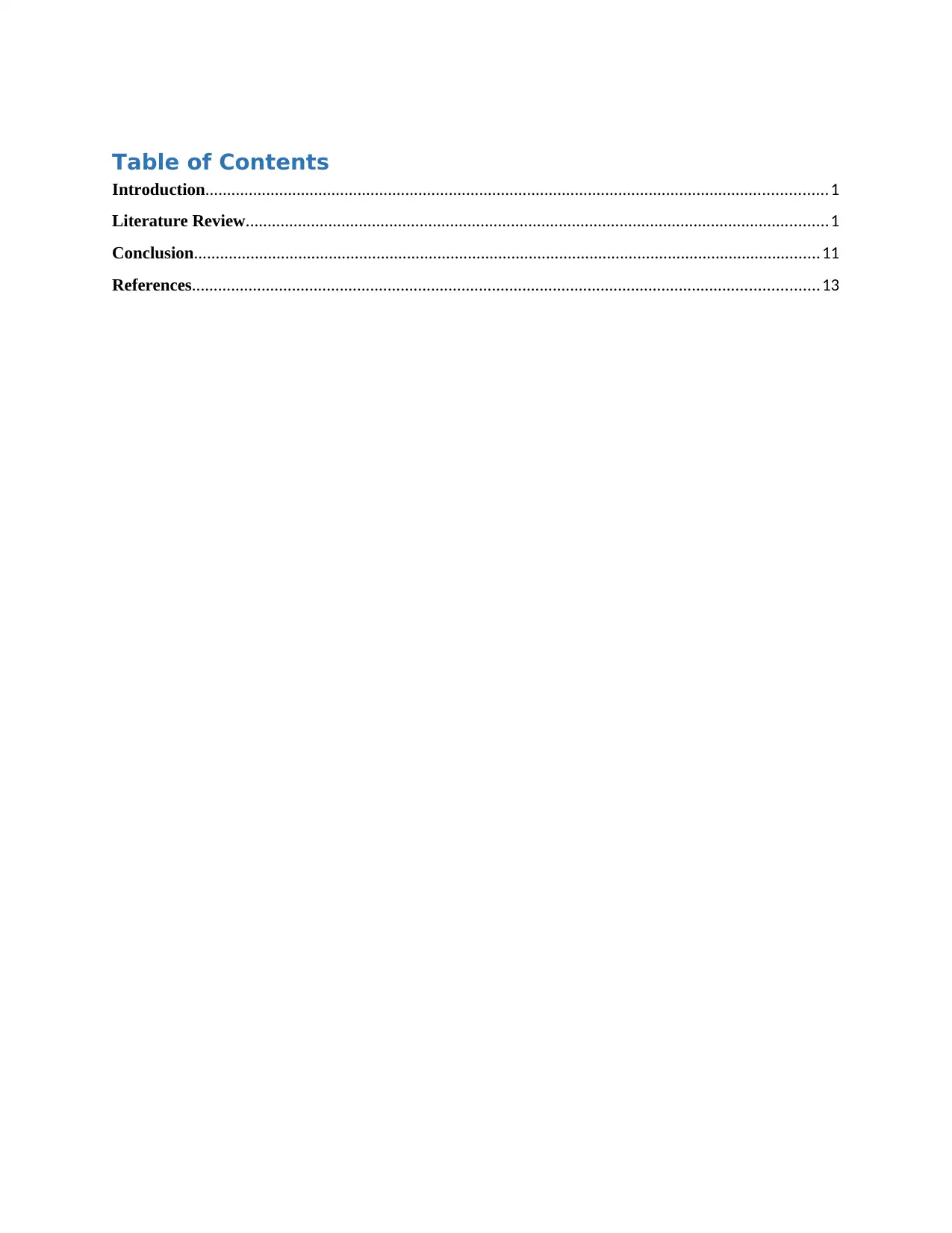
Table of Contents
Introduction...............................................................................................................................................1
Literature Review......................................................................................................................................1
Conclusion................................................................................................................................................11
References................................................................................................................................................13
Introduction...............................................................................................................................................1
Literature Review......................................................................................................................................1
Conclusion................................................................................................................................................11
References................................................................................................................................................13
Paraphrase This Document
Need a fresh take? Get an instant paraphrase of this document with our AI Paraphraser
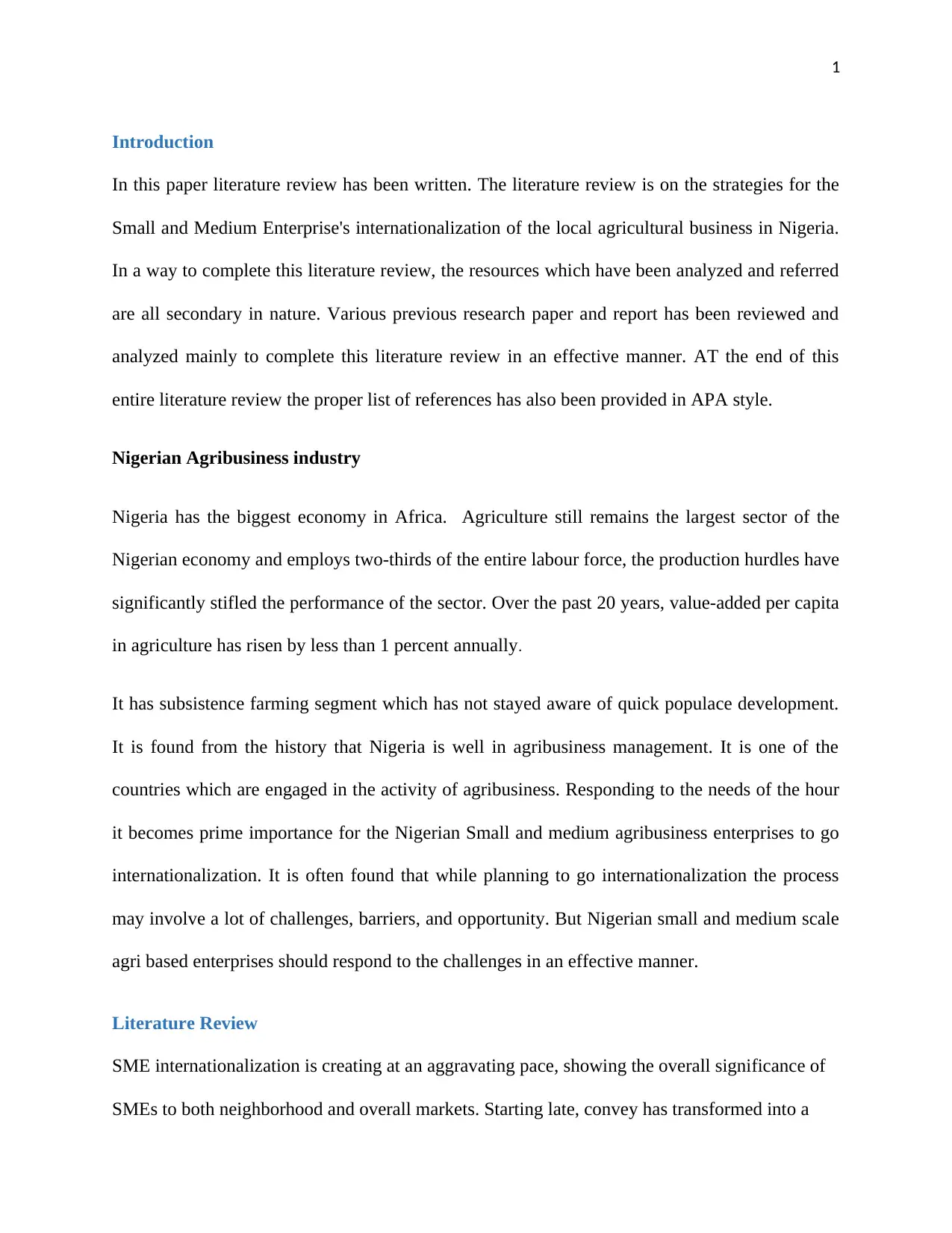
1
Introduction
In this paper literature review has been written. The literature review is on the strategies for the
Small and Medium Enterprise's internationalization of the local agricultural business in Nigeria.
In a way to complete this literature review, the resources which have been analyzed and referred
are all secondary in nature. Various previous research paper and report has been reviewed and
analyzed mainly to complete this literature review in an effective manner. AT the end of this
entire literature review the proper list of references has also been provided in APA style.
Nigerian Agribusiness industry
Nigeria has the biggest economy in Africa. Agriculture still remains the largest sector of the
Nigerian economy and employs two-thirds of the entire labour force, the production hurdles have
significantly stifled the performance of the sector. Over the past 20 years, value-added per capita
in agriculture has risen by less than 1 percent annually.
It has subsistence farming segment which has not stayed aware of quick populace development.
It is found from the history that Nigeria is well in agribusiness management. It is one of the
countries which are engaged in the activity of agribusiness. Responding to the needs of the hour
it becomes prime importance for the Nigerian Small and medium agribusiness enterprises to go
internationalization. It is often found that while planning to go internationalization the process
may involve a lot of challenges, barriers, and opportunity. But Nigerian small and medium scale
agri based enterprises should respond to the challenges in an effective manner.
Literature Review
SME internationalization is creating at an aggravating pace, showing the overall significance of
SMEs to both neighborhood and overall markets. Starting late, convey has transformed into a
Introduction
In this paper literature review has been written. The literature review is on the strategies for the
Small and Medium Enterprise's internationalization of the local agricultural business in Nigeria.
In a way to complete this literature review, the resources which have been analyzed and referred
are all secondary in nature. Various previous research paper and report has been reviewed and
analyzed mainly to complete this literature review in an effective manner. AT the end of this
entire literature review the proper list of references has also been provided in APA style.
Nigerian Agribusiness industry
Nigeria has the biggest economy in Africa. Agriculture still remains the largest sector of the
Nigerian economy and employs two-thirds of the entire labour force, the production hurdles have
significantly stifled the performance of the sector. Over the past 20 years, value-added per capita
in agriculture has risen by less than 1 percent annually.
It has subsistence farming segment which has not stayed aware of quick populace development.
It is found from the history that Nigeria is well in agribusiness management. It is one of the
countries which are engaged in the activity of agribusiness. Responding to the needs of the hour
it becomes prime importance for the Nigerian Small and medium agribusiness enterprises to go
internationalization. It is often found that while planning to go internationalization the process
may involve a lot of challenges, barriers, and opportunity. But Nigerian small and medium scale
agri based enterprises should respond to the challenges in an effective manner.
Literature Review
SME internationalization is creating at an aggravating pace, showing the overall significance of
SMEs to both neighborhood and overall markets. Starting late, convey has transformed into a
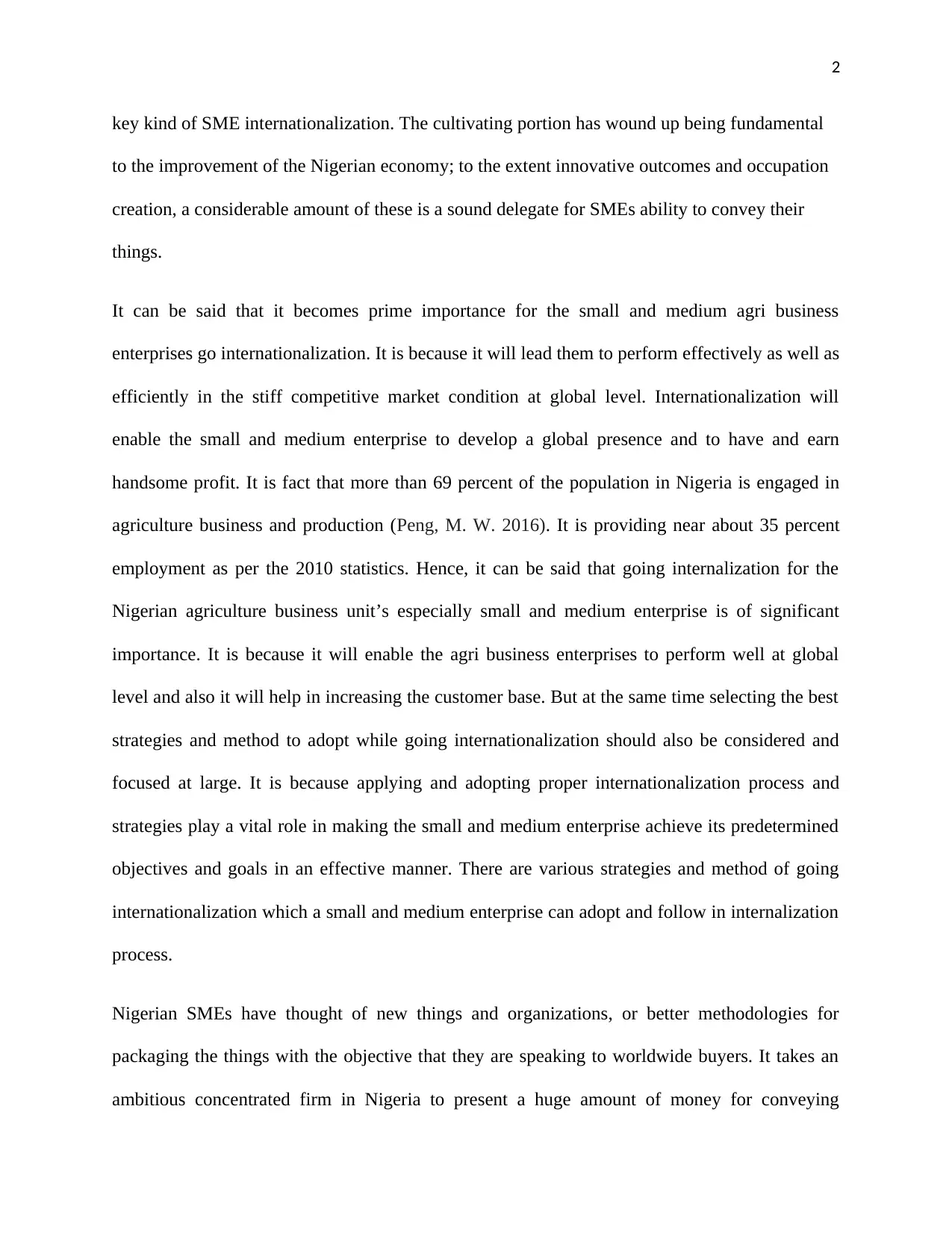
2
key kind of SME internationalization. The cultivating portion has wound up being fundamental
to the improvement of the Nigerian economy; to the extent innovative outcomes and occupation
creation, a considerable amount of these is a sound delegate for SMEs ability to convey their
things.
It can be said that it becomes prime importance for the small and medium agri business
enterprises go internationalization. It is because it will lead them to perform effectively as well as
efficiently in the stiff competitive market condition at global level. Internationalization will
enable the small and medium enterprise to develop a global presence and to have and earn
handsome profit. It is fact that more than 69 percent of the population in Nigeria is engaged in
agriculture business and production (Peng, M. W. 2016). It is providing near about 35 percent
employment as per the 2010 statistics. Hence, it can be said that going internalization for the
Nigerian agriculture business unit’s especially small and medium enterprise is of significant
importance. It is because it will enable the agri business enterprises to perform well at global
level and also it will help in increasing the customer base. But at the same time selecting the best
strategies and method to adopt while going internationalization should also be considered and
focused at large. It is because applying and adopting proper internationalization process and
strategies play a vital role in making the small and medium enterprise achieve its predetermined
objectives and goals in an effective manner. There are various strategies and method of going
internationalization which a small and medium enterprise can adopt and follow in internalization
process.
Nigerian SMEs have thought of new things and organizations, or better methodologies for
packaging the things with the objective that they are speaking to worldwide buyers. It takes an
ambitious concentrated firm in Nigeria to present a huge amount of money for conveying
key kind of SME internationalization. The cultivating portion has wound up being fundamental
to the improvement of the Nigerian economy; to the extent innovative outcomes and occupation
creation, a considerable amount of these is a sound delegate for SMEs ability to convey their
things.
It can be said that it becomes prime importance for the small and medium agri business
enterprises go internationalization. It is because it will lead them to perform effectively as well as
efficiently in the stiff competitive market condition at global level. Internationalization will
enable the small and medium enterprise to develop a global presence and to have and earn
handsome profit. It is fact that more than 69 percent of the population in Nigeria is engaged in
agriculture business and production (Peng, M. W. 2016). It is providing near about 35 percent
employment as per the 2010 statistics. Hence, it can be said that going internalization for the
Nigerian agriculture business unit’s especially small and medium enterprise is of significant
importance. It is because it will enable the agri business enterprises to perform well at global
level and also it will help in increasing the customer base. But at the same time selecting the best
strategies and method to adopt while going internationalization should also be considered and
focused at large. It is because applying and adopting proper internationalization process and
strategies play a vital role in making the small and medium enterprise achieve its predetermined
objectives and goals in an effective manner. There are various strategies and method of going
internationalization which a small and medium enterprise can adopt and follow in internalization
process.
Nigerian SMEs have thought of new things and organizations, or better methodologies for
packaging the things with the objective that they are speaking to worldwide buyers. It takes an
ambitious concentrated firm in Nigeria to present a huge amount of money for conveying
⊘ This is a preview!⊘
Do you want full access?
Subscribe today to unlock all pages.

Trusted by 1+ million students worldwide
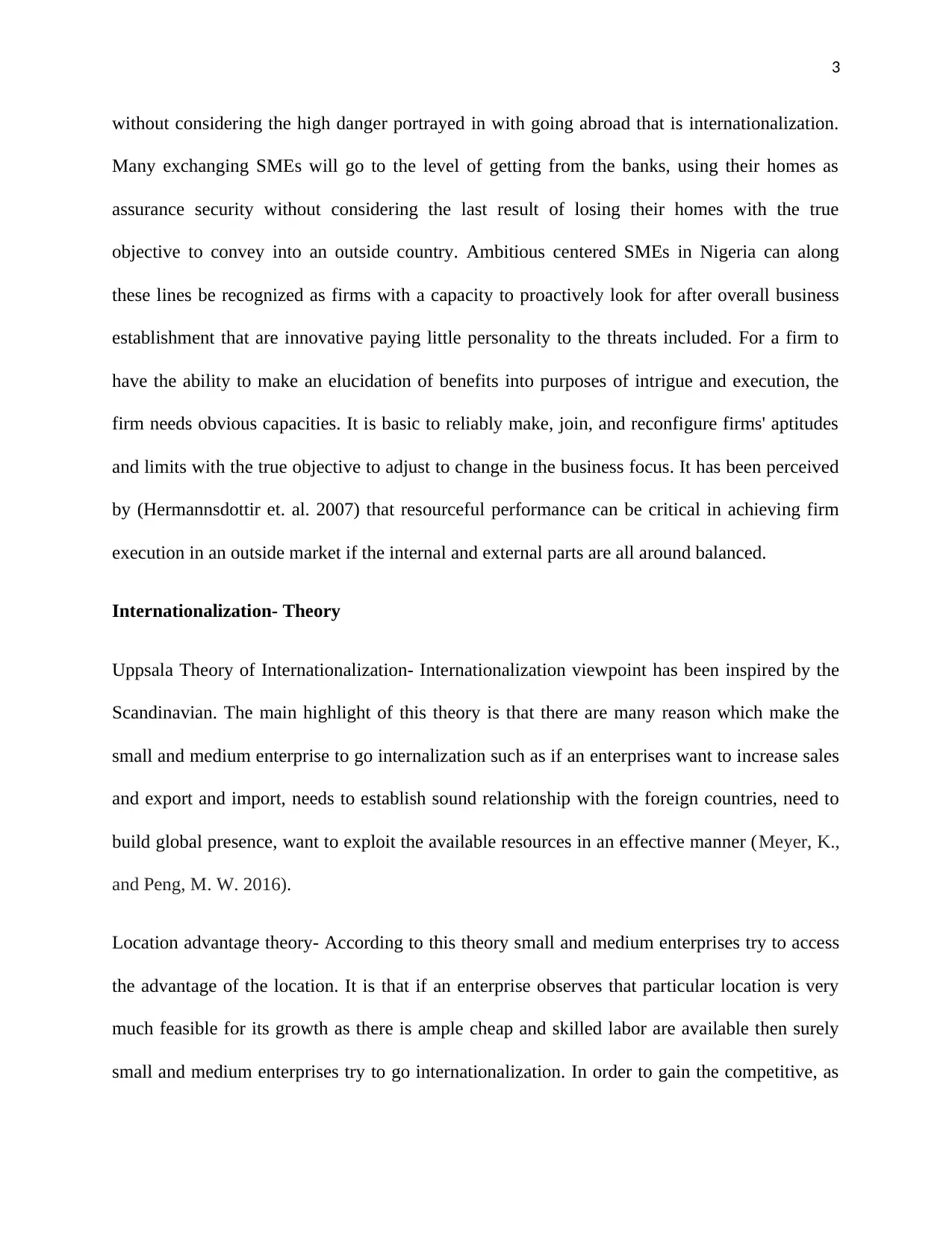
3
without considering the high danger portrayed in with going abroad that is internationalization.
Many exchanging SMEs will go to the level of getting from the banks, using their homes as
assurance security without considering the last result of losing their homes with the true
objective to convey into an outside country. Ambitious centered SMEs in Nigeria can along
these lines be recognized as firms with a capacity to proactively look for after overall business
establishment that are innovative paying little personality to the threats included. For a firm to
have the ability to make an elucidation of benefits into purposes of intrigue and execution, the
firm needs obvious capacities. It is basic to reliably make, join, and reconfigure firms' aptitudes
and limits with the true objective to adjust to change in the business focus. It has been perceived
by (Hermannsdottir et. al. 2007) that resourceful performance can be critical in achieving firm
execution in an outside market if the internal and external parts are all around balanced.
Internationalization- Theory
Uppsala Theory of Internationalization- Internationalization viewpoint has been inspired by the
Scandinavian. The main highlight of this theory is that there are many reason which make the
small and medium enterprise to go internalization such as if an enterprises want to increase sales
and export and import, needs to establish sound relationship with the foreign countries, need to
build global presence, want to exploit the available resources in an effective manner (Meyer, K.,
and Peng, M. W. 2016).
Location advantage theory- According to this theory small and medium enterprises try to access
the advantage of the location. It is that if an enterprise observes that particular location is very
much feasible for its growth as there is ample cheap and skilled labor are available then surely
small and medium enterprises try to go internationalization. In order to gain the competitive, as
without considering the high danger portrayed in with going abroad that is internationalization.
Many exchanging SMEs will go to the level of getting from the banks, using their homes as
assurance security without considering the last result of losing their homes with the true
objective to convey into an outside country. Ambitious centered SMEs in Nigeria can along
these lines be recognized as firms with a capacity to proactively look for after overall business
establishment that are innovative paying little personality to the threats included. For a firm to
have the ability to make an elucidation of benefits into purposes of intrigue and execution, the
firm needs obvious capacities. It is basic to reliably make, join, and reconfigure firms' aptitudes
and limits with the true objective to adjust to change in the business focus. It has been perceived
by (Hermannsdottir et. al. 2007) that resourceful performance can be critical in achieving firm
execution in an outside market if the internal and external parts are all around balanced.
Internationalization- Theory
Uppsala Theory of Internationalization- Internationalization viewpoint has been inspired by the
Scandinavian. The main highlight of this theory is that there are many reason which make the
small and medium enterprise to go internalization such as if an enterprises want to increase sales
and export and import, needs to establish sound relationship with the foreign countries, need to
build global presence, want to exploit the available resources in an effective manner (Meyer, K.,
and Peng, M. W. 2016).
Location advantage theory- According to this theory small and medium enterprises try to access
the advantage of the location. It is that if an enterprise observes that particular location is very
much feasible for its growth as there is ample cheap and skilled labor are available then surely
small and medium enterprises try to go internationalization. In order to gain the competitive, as
Paraphrase This Document
Need a fresh take? Get an instant paraphrase of this document with our AI Paraphraser
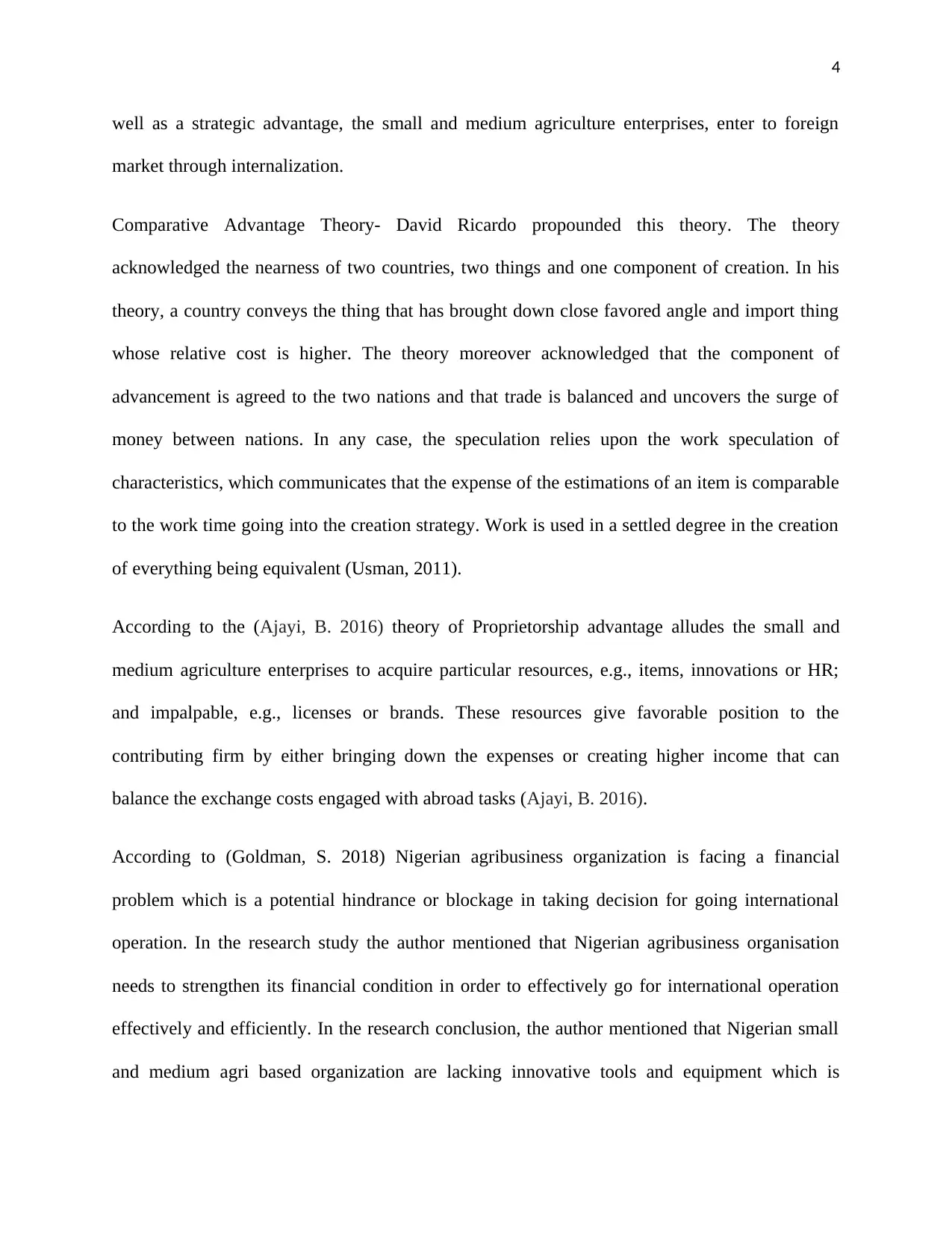
4
well as a strategic advantage, the small and medium agriculture enterprises, enter to foreign
market through internalization.
Comparative Advantage Theory- David Ricardo propounded this theory. The theory
acknowledged the nearness of two countries, two things and one component of creation. In his
theory, a country conveys the thing that has brought down close favored angle and import thing
whose relative cost is higher. The theory moreover acknowledged that the component of
advancement is agreed to the two nations and that trade is balanced and uncovers the surge of
money between nations. In any case, the speculation relies upon the work speculation of
characteristics, which communicates that the expense of the estimations of an item is comparable
to the work time going into the creation strategy. Work is used in a settled degree in the creation
of everything being equivalent (Usman, 2011).
According to the (Ajayi, B. 2016) theory of Proprietorship advantage alludes the small and
medium agriculture enterprises to acquire particular resources, e.g., items, innovations or HR;
and impalpable, e.g., licenses or brands. These resources give favorable position to the
contributing firm by either bringing down the expenses or creating higher income that can
balance the exchange costs engaged with abroad tasks (Ajayi, B. 2016).
According to (Goldman, S. 2018) Nigerian agribusiness organization is facing a financial
problem which is a potential hindrance or blockage in taking decision for going international
operation. In the research study the author mentioned that Nigerian agribusiness organisation
needs to strengthen its financial condition in order to effectively go for international operation
effectively and efficiently. In the research conclusion, the author mentioned that Nigerian small
and medium agri based organization are lacking innovative tools and equipment which is
well as a strategic advantage, the small and medium agriculture enterprises, enter to foreign
market through internalization.
Comparative Advantage Theory- David Ricardo propounded this theory. The theory
acknowledged the nearness of two countries, two things and one component of creation. In his
theory, a country conveys the thing that has brought down close favored angle and import thing
whose relative cost is higher. The theory moreover acknowledged that the component of
advancement is agreed to the two nations and that trade is balanced and uncovers the surge of
money between nations. In any case, the speculation relies upon the work speculation of
characteristics, which communicates that the expense of the estimations of an item is comparable
to the work time going into the creation strategy. Work is used in a settled degree in the creation
of everything being equivalent (Usman, 2011).
According to the (Ajayi, B. 2016) theory of Proprietorship advantage alludes the small and
medium agriculture enterprises to acquire particular resources, e.g., items, innovations or HR;
and impalpable, e.g., licenses or brands. These resources give favorable position to the
contributing firm by either bringing down the expenses or creating higher income that can
balance the exchange costs engaged with abroad tasks (Ajayi, B. 2016).
According to (Goldman, S. 2018) Nigerian agribusiness organization is facing a financial
problem which is a potential hindrance or blockage in taking decision for going international
operation. In the research study the author mentioned that Nigerian agribusiness organisation
needs to strengthen its financial condition in order to effectively go for international operation
effectively and efficiently. In the research conclusion, the author mentioned that Nigerian small
and medium agri based organization are lacking innovative tools and equipment which is
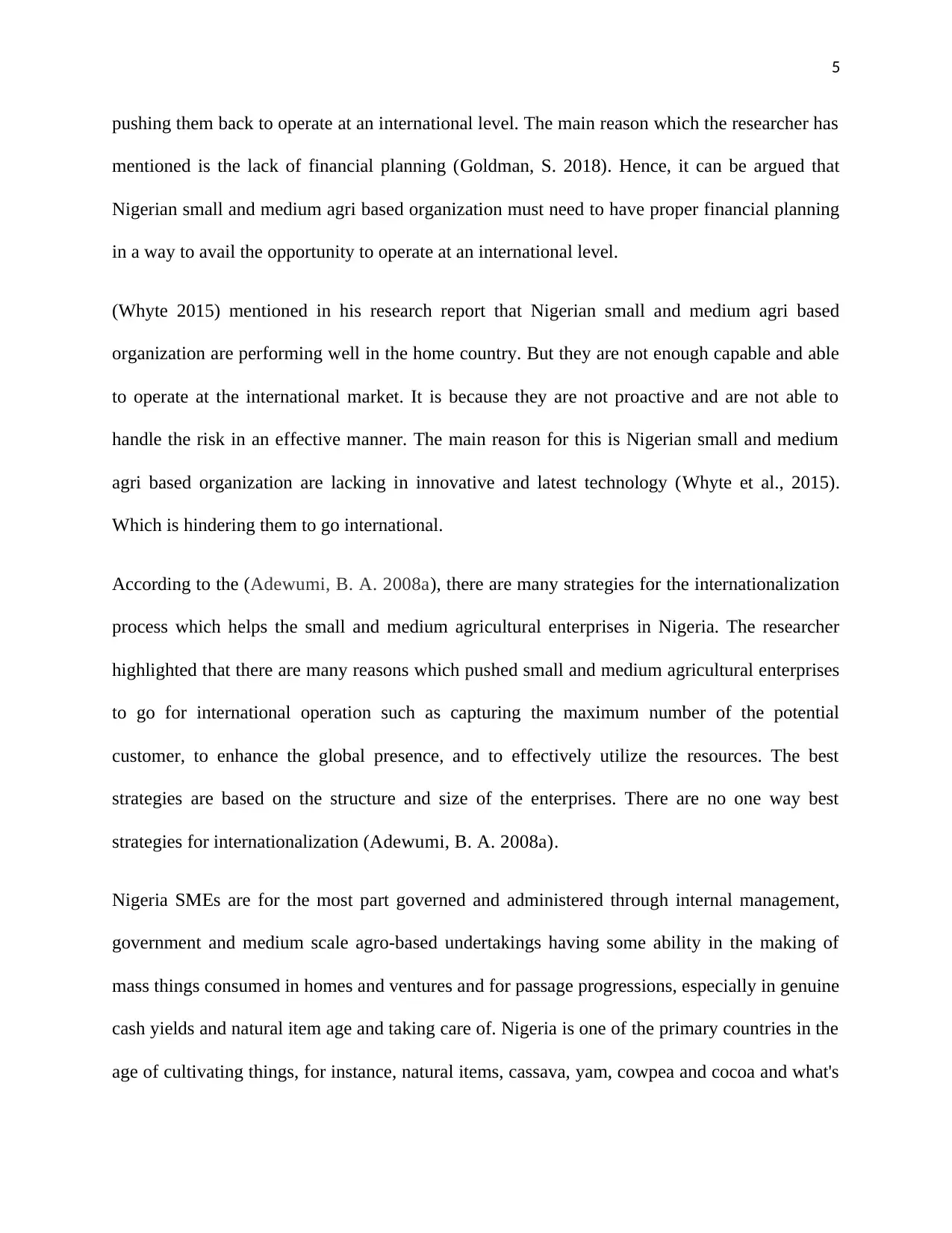
5
pushing them back to operate at an international level. The main reason which the researcher has
mentioned is the lack of financial planning (Goldman, S. 2018). Hence, it can be argued that
Nigerian small and medium agri based organization must need to have proper financial planning
in a way to avail the opportunity to operate at an international level.
(Whyte 2015) mentioned in his research report that Nigerian small and medium agri based
organization are performing well in the home country. But they are not enough capable and able
to operate at the international market. It is because they are not proactive and are not able to
handle the risk in an effective manner. The main reason for this is Nigerian small and medium
agri based organization are lacking in innovative and latest technology (Whyte et al., 2015).
Which is hindering them to go international.
According to the (Adewumi, B. A. 2008a), there are many strategies for the internationalization
process which helps the small and medium agricultural enterprises in Nigeria. The researcher
highlighted that there are many reasons which pushed small and medium agricultural enterprises
to go for international operation such as capturing the maximum number of the potential
customer, to enhance the global presence, and to effectively utilize the resources. The best
strategies are based on the structure and size of the enterprises. There are no one way best
strategies for internationalization (Adewumi, B. A. 2008a).
Nigeria SMEs are for the most part governed and administered through internal management,
government and medium scale agro-based undertakings having some ability in the making of
mass things consumed in homes and ventures and for passage progressions, especially in genuine
cash yields and natural item age and taking care of. Nigeria is one of the primary countries in the
age of cultivating things, for instance, natural items, cassava, yam, cowpea and cocoa and what's
pushing them back to operate at an international level. The main reason which the researcher has
mentioned is the lack of financial planning (Goldman, S. 2018). Hence, it can be argued that
Nigerian small and medium agri based organization must need to have proper financial planning
in a way to avail the opportunity to operate at an international level.
(Whyte 2015) mentioned in his research report that Nigerian small and medium agri based
organization are performing well in the home country. But they are not enough capable and able
to operate at the international market. It is because they are not proactive and are not able to
handle the risk in an effective manner. The main reason for this is Nigerian small and medium
agri based organization are lacking in innovative and latest technology (Whyte et al., 2015).
Which is hindering them to go international.
According to the (Adewumi, B. A. 2008a), there are many strategies for the internationalization
process which helps the small and medium agricultural enterprises in Nigeria. The researcher
highlighted that there are many reasons which pushed small and medium agricultural enterprises
to go for international operation such as capturing the maximum number of the potential
customer, to enhance the global presence, and to effectively utilize the resources. The best
strategies are based on the structure and size of the enterprises. There are no one way best
strategies for internationalization (Adewumi, B. A. 2008a).
Nigeria SMEs are for the most part governed and administered through internal management,
government and medium scale agro-based undertakings having some ability in the making of
mass things consumed in homes and ventures and for passage progressions, especially in genuine
cash yields and natural item age and taking care of. Nigeria is one of the primary countries in the
age of cultivating things, for instance, natural items, cassava, yam, cowpea and cocoa and what's
⊘ This is a preview!⊘
Do you want full access?
Subscribe today to unlock all pages.

Trusted by 1+ million students worldwide
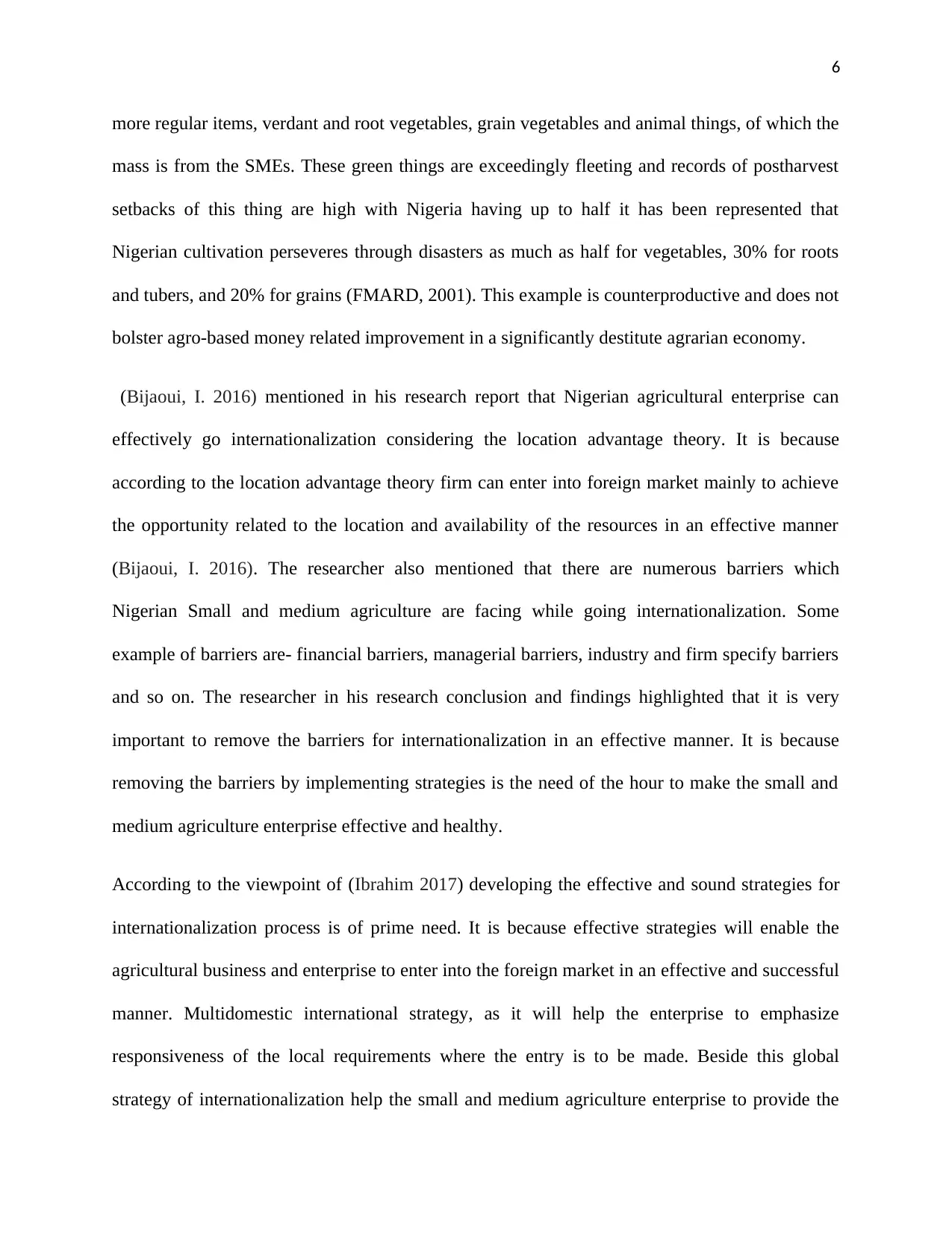
6
more regular items, verdant and root vegetables, grain vegetables and animal things, of which the
mass is from the SMEs. These green things are exceedingly fleeting and records of postharvest
setbacks of this thing are high with Nigeria having up to half it has been represented that
Nigerian cultivation perseveres through disasters as much as half for vegetables, 30% for roots
and tubers, and 20% for grains (FMARD, 2001). This example is counterproductive and does not
bolster agro-based money related improvement in a significantly destitute agrarian economy.
(Bijaoui, I. 2016) mentioned in his research report that Nigerian agricultural enterprise can
effectively go internationalization considering the location advantage theory. It is because
according to the location advantage theory firm can enter into foreign market mainly to achieve
the opportunity related to the location and availability of the resources in an effective manner
(Bijaoui, I. 2016). The researcher also mentioned that there are numerous barriers which
Nigerian Small and medium agriculture are facing while going internationalization. Some
example of barriers are- financial barriers, managerial barriers, industry and firm specify barriers
and so on. The researcher in his research conclusion and findings highlighted that it is very
important to remove the barriers for internationalization in an effective manner. It is because
removing the barriers by implementing strategies is the need of the hour to make the small and
medium agriculture enterprise effective and healthy.
According to the viewpoint of (Ibrahim 2017) developing the effective and sound strategies for
internationalization process is of prime need. It is because effective strategies will enable the
agricultural business and enterprise to enter into the foreign market in an effective and successful
manner. Multidomestic international strategy, as it will help the enterprise to emphasize
responsiveness of the local requirements where the entry is to be made. Beside this global
strategy of internationalization help the small and medium agriculture enterprise to provide the
more regular items, verdant and root vegetables, grain vegetables and animal things, of which the
mass is from the SMEs. These green things are exceedingly fleeting and records of postharvest
setbacks of this thing are high with Nigeria having up to half it has been represented that
Nigerian cultivation perseveres through disasters as much as half for vegetables, 30% for roots
and tubers, and 20% for grains (FMARD, 2001). This example is counterproductive and does not
bolster agro-based money related improvement in a significantly destitute agrarian economy.
(Bijaoui, I. 2016) mentioned in his research report that Nigerian agricultural enterprise can
effectively go internationalization considering the location advantage theory. It is because
according to the location advantage theory firm can enter into foreign market mainly to achieve
the opportunity related to the location and availability of the resources in an effective manner
(Bijaoui, I. 2016). The researcher also mentioned that there are numerous barriers which
Nigerian Small and medium agriculture are facing while going internationalization. Some
example of barriers are- financial barriers, managerial barriers, industry and firm specify barriers
and so on. The researcher in his research conclusion and findings highlighted that it is very
important to remove the barriers for internationalization in an effective manner. It is because
removing the barriers by implementing strategies is the need of the hour to make the small and
medium agriculture enterprise effective and healthy.
According to the viewpoint of (Ibrahim 2017) developing the effective and sound strategies for
internationalization process is of prime need. It is because effective strategies will enable the
agricultural business and enterprise to enter into the foreign market in an effective and successful
manner. Multidomestic international strategy, as it will help the enterprise to emphasize
responsiveness of the local requirements where the entry is to be made. Beside this global
strategy of internationalization help the small and medium agriculture enterprise to provide the
Paraphrase This Document
Need a fresh take? Get an instant paraphrase of this document with our AI Paraphraser
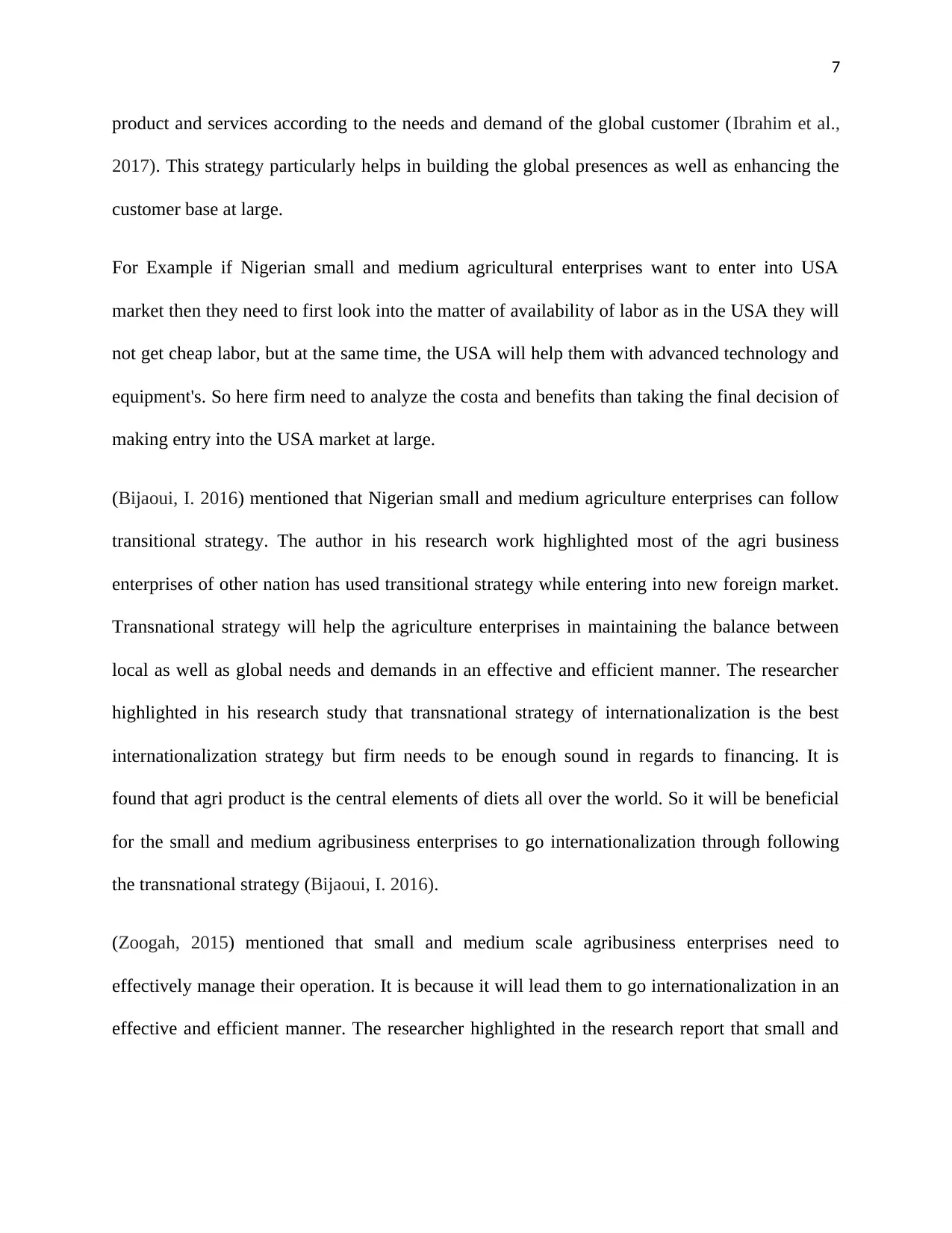
7
product and services according to the needs and demand of the global customer (Ibrahim et al.,
2017). This strategy particularly helps in building the global presences as well as enhancing the
customer base at large.
For Example if Nigerian small and medium agricultural enterprises want to enter into USA
market then they need to first look into the matter of availability of labor as in the USA they will
not get cheap labor, but at the same time, the USA will help them with advanced technology and
equipment's. So here firm need to analyze the costa and benefits than taking the final decision of
making entry into the USA market at large.
(Bijaoui, I. 2016) mentioned that Nigerian small and medium agriculture enterprises can follow
transitional strategy. The author in his research work highlighted most of the agri business
enterprises of other nation has used transitional strategy while entering into new foreign market.
Transnational strategy will help the agriculture enterprises in maintaining the balance between
local as well as global needs and demands in an effective and efficient manner. The researcher
highlighted in his research study that transnational strategy of internationalization is the best
internationalization strategy but firm needs to be enough sound in regards to financing. It is
found that agri product is the central elements of diets all over the world. So it will be beneficial
for the small and medium agribusiness enterprises to go internationalization through following
the transnational strategy (Bijaoui, I. 2016).
(Zoogah, 2015) mentioned that small and medium scale agribusiness enterprises need to
effectively manage their operation. It is because it will lead them to go internationalization in an
effective and efficient manner. The researcher highlighted in the research report that small and
product and services according to the needs and demand of the global customer (Ibrahim et al.,
2017). This strategy particularly helps in building the global presences as well as enhancing the
customer base at large.
For Example if Nigerian small and medium agricultural enterprises want to enter into USA
market then they need to first look into the matter of availability of labor as in the USA they will
not get cheap labor, but at the same time, the USA will help them with advanced technology and
equipment's. So here firm need to analyze the costa and benefits than taking the final decision of
making entry into the USA market at large.
(Bijaoui, I. 2016) mentioned that Nigerian small and medium agriculture enterprises can follow
transitional strategy. The author in his research work highlighted most of the agri business
enterprises of other nation has used transitional strategy while entering into new foreign market.
Transnational strategy will help the agriculture enterprises in maintaining the balance between
local as well as global needs and demands in an effective and efficient manner. The researcher
highlighted in his research study that transnational strategy of internationalization is the best
internationalization strategy but firm needs to be enough sound in regards to financing. It is
found that agri product is the central elements of diets all over the world. So it will be beneficial
for the small and medium agribusiness enterprises to go internationalization through following
the transnational strategy (Bijaoui, I. 2016).
(Zoogah, 2015) mentioned that small and medium scale agribusiness enterprises need to
effectively manage their operation. It is because it will lead them to go internationalization in an
effective and efficient manner. The researcher highlighted in the research report that small and
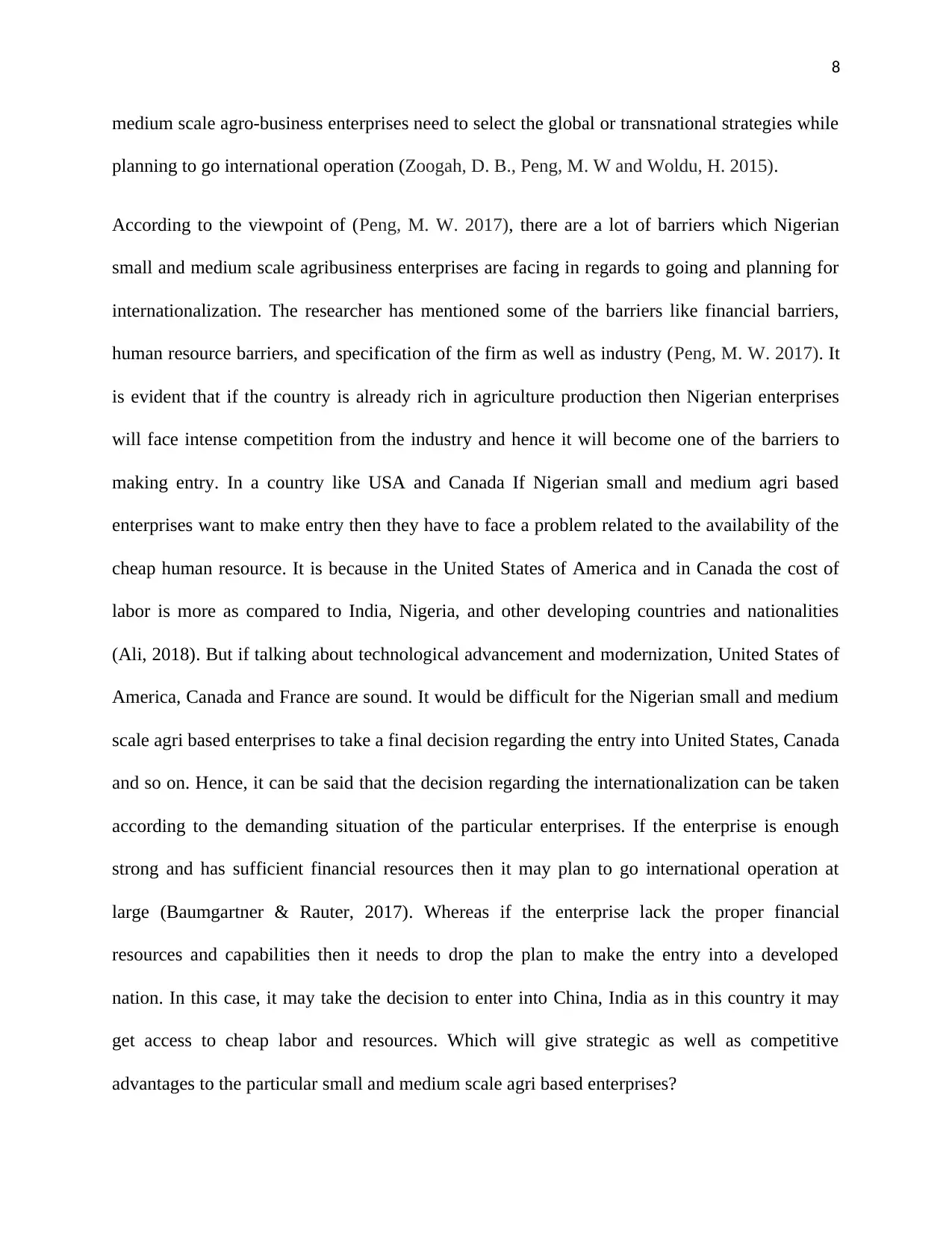
8
medium scale agro-business enterprises need to select the global or transnational strategies while
planning to go international operation (Zoogah, D. B., Peng, M. W and Woldu, H. 2015).
According to the viewpoint of (Peng, M. W. 2017), there are a lot of barriers which Nigerian
small and medium scale agribusiness enterprises are facing in regards to going and planning for
internationalization. The researcher has mentioned some of the barriers like financial barriers,
human resource barriers, and specification of the firm as well as industry (Peng, M. W. 2017). It
is evident that if the country is already rich in agriculture production then Nigerian enterprises
will face intense competition from the industry and hence it will become one of the barriers to
making entry. In a country like USA and Canada If Nigerian small and medium agri based
enterprises want to make entry then they have to face a problem related to the availability of the
cheap human resource. It is because in the United States of America and in Canada the cost of
labor is more as compared to India, Nigeria, and other developing countries and nationalities
(Ali, 2018). But if talking about technological advancement and modernization, United States of
America, Canada and France are sound. It would be difficult for the Nigerian small and medium
scale agri based enterprises to take a final decision regarding the entry into United States, Canada
and so on. Hence, it can be said that the decision regarding the internationalization can be taken
according to the demanding situation of the particular enterprises. If the enterprise is enough
strong and has sufficient financial resources then it may plan to go international operation at
large (Baumgartner & Rauter, 2017). Whereas if the enterprise lack the proper financial
resources and capabilities then it needs to drop the plan to make the entry into a developed
nation. In this case, it may take the decision to enter into China, India as in this country it may
get access to cheap labor and resources. Which will give strategic as well as competitive
advantages to the particular small and medium scale agri based enterprises?
medium scale agro-business enterprises need to select the global or transnational strategies while
planning to go international operation (Zoogah, D. B., Peng, M. W and Woldu, H. 2015).
According to the viewpoint of (Peng, M. W. 2017), there are a lot of barriers which Nigerian
small and medium scale agribusiness enterprises are facing in regards to going and planning for
internationalization. The researcher has mentioned some of the barriers like financial barriers,
human resource barriers, and specification of the firm as well as industry (Peng, M. W. 2017). It
is evident that if the country is already rich in agriculture production then Nigerian enterprises
will face intense competition from the industry and hence it will become one of the barriers to
making entry. In a country like USA and Canada If Nigerian small and medium agri based
enterprises want to make entry then they have to face a problem related to the availability of the
cheap human resource. It is because in the United States of America and in Canada the cost of
labor is more as compared to India, Nigeria, and other developing countries and nationalities
(Ali, 2018). But if talking about technological advancement and modernization, United States of
America, Canada and France are sound. It would be difficult for the Nigerian small and medium
scale agri based enterprises to take a final decision regarding the entry into United States, Canada
and so on. Hence, it can be said that the decision regarding the internationalization can be taken
according to the demanding situation of the particular enterprises. If the enterprise is enough
strong and has sufficient financial resources then it may plan to go international operation at
large (Baumgartner & Rauter, 2017). Whereas if the enterprise lack the proper financial
resources and capabilities then it needs to drop the plan to make the entry into a developed
nation. In this case, it may take the decision to enter into China, India as in this country it may
get access to cheap labor and resources. Which will give strategic as well as competitive
advantages to the particular small and medium scale agri based enterprises?
⊘ This is a preview!⊘
Do you want full access?
Subscribe today to unlock all pages.

Trusted by 1+ million students worldwide
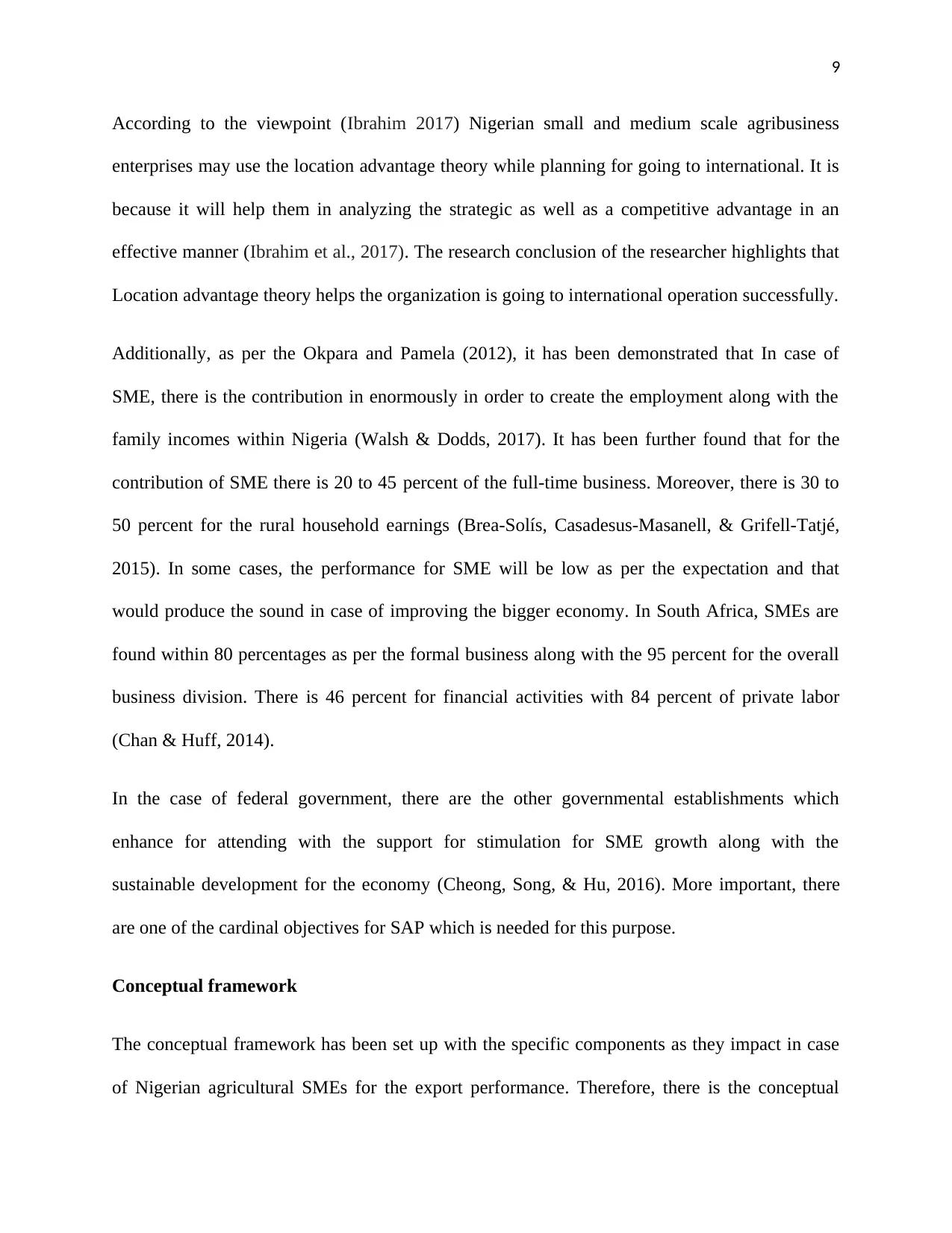
9
According to the viewpoint (Ibrahim 2017) Nigerian small and medium scale agribusiness
enterprises may use the location advantage theory while planning for going to international. It is
because it will help them in analyzing the strategic as well as a competitive advantage in an
effective manner (Ibrahim et al., 2017). The research conclusion of the researcher highlights that
Location advantage theory helps the organization is going to international operation successfully.
Additionally, as per the Okpara and Pamela (2012), it has been demonstrated that In case of
SME, there is the contribution in enormously in order to create the employment along with the
family incomes within Nigeria (Walsh & Dodds, 2017). It has been further found that for the
contribution of SME there is 20 to 45 percent of the full-time business. Moreover, there is 30 to
50 percent for the rural household earnings (Brea‐Solís, Casadesus‐Masanell, & Grifell‐Tatjé,
2015). In some cases, the performance for SME will be low as per the expectation and that
would produce the sound in case of improving the bigger economy. In South Africa, SMEs are
found within 80 percentages as per the formal business along with the 95 percent for the overall
business division. There is 46 percent for financial activities with 84 percent of private labor
(Chan & Huff, 2014).
In the case of federal government, there are the other governmental establishments which
enhance for attending with the support for stimulation for SME growth along with the
sustainable development for the economy (Cheong, Song, & Hu, 2016). More important, there
are one of the cardinal objectives for SAP which is needed for this purpose.
Conceptual framework
The conceptual framework has been set up with the specific components as they impact in case
of Nigerian agricultural SMEs for the export performance. Therefore, there is the conceptual
According to the viewpoint (Ibrahim 2017) Nigerian small and medium scale agribusiness
enterprises may use the location advantage theory while planning for going to international. It is
because it will help them in analyzing the strategic as well as a competitive advantage in an
effective manner (Ibrahim et al., 2017). The research conclusion of the researcher highlights that
Location advantage theory helps the organization is going to international operation successfully.
Additionally, as per the Okpara and Pamela (2012), it has been demonstrated that In case of
SME, there is the contribution in enormously in order to create the employment along with the
family incomes within Nigeria (Walsh & Dodds, 2017). It has been further found that for the
contribution of SME there is 20 to 45 percent of the full-time business. Moreover, there is 30 to
50 percent for the rural household earnings (Brea‐Solís, Casadesus‐Masanell, & Grifell‐Tatjé,
2015). In some cases, the performance for SME will be low as per the expectation and that
would produce the sound in case of improving the bigger economy. In South Africa, SMEs are
found within 80 percentages as per the formal business along with the 95 percent for the overall
business division. There is 46 percent for financial activities with 84 percent of private labor
(Chan & Huff, 2014).
In the case of federal government, there are the other governmental establishments which
enhance for attending with the support for stimulation for SME growth along with the
sustainable development for the economy (Cheong, Song, & Hu, 2016). More important, there
are one of the cardinal objectives for SAP which is needed for this purpose.
Conceptual framework
The conceptual framework has been set up with the specific components as they impact in case
of Nigerian agricultural SMEs for the export performance. Therefore, there is the conceptual
Paraphrase This Document
Need a fresh take? Get an instant paraphrase of this document with our AI Paraphraser
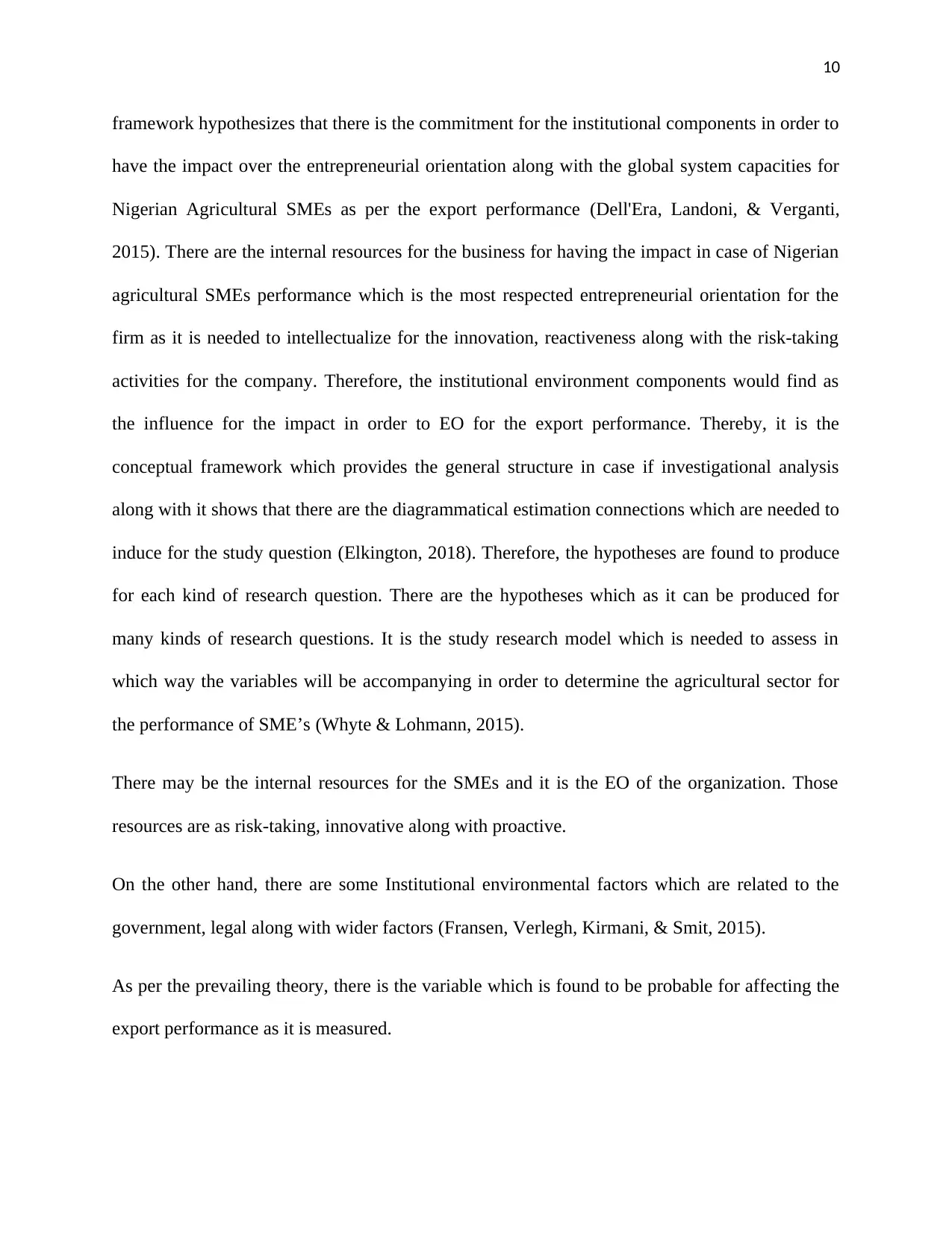
10
framework hypothesizes that there is the commitment for the institutional components in order to
have the impact over the entrepreneurial orientation along with the global system capacities for
Nigerian Agricultural SMEs as per the export performance (Dell'Era, Landoni, & Verganti,
2015). There are the internal resources for the business for having the impact in case of Nigerian
agricultural SMEs performance which is the most respected entrepreneurial orientation for the
firm as it is needed to intellectualize for the innovation, reactiveness along with the risk-taking
activities for the company. Therefore, the institutional environment components would find as
the influence for the impact in order to EO for the export performance. Thereby, it is the
conceptual framework which provides the general structure in case if investigational analysis
along with it shows that there are the diagrammatical estimation connections which are needed to
induce for the study question (Elkington, 2018). Therefore, the hypotheses are found to produce
for each kind of research question. There are the hypotheses which as it can be produced for
many kinds of research questions. It is the study research model which is needed to assess in
which way the variables will be accompanying in order to determine the agricultural sector for
the performance of SME’s (Whyte & Lohmann, 2015).
There may be the internal resources for the SMEs and it is the EO of the organization. Those
resources are as risk-taking, innovative along with proactive.
On the other hand, there are some Institutional environmental factors which are related to the
government, legal along with wider factors (Fransen, Verlegh, Kirmani, & Smit, 2015).
As per the prevailing theory, there is the variable which is found to be probable for affecting the
export performance as it is measured.
framework hypothesizes that there is the commitment for the institutional components in order to
have the impact over the entrepreneurial orientation along with the global system capacities for
Nigerian Agricultural SMEs as per the export performance (Dell'Era, Landoni, & Verganti,
2015). There are the internal resources for the business for having the impact in case of Nigerian
agricultural SMEs performance which is the most respected entrepreneurial orientation for the
firm as it is needed to intellectualize for the innovation, reactiveness along with the risk-taking
activities for the company. Therefore, the institutional environment components would find as
the influence for the impact in order to EO for the export performance. Thereby, it is the
conceptual framework which provides the general structure in case if investigational analysis
along with it shows that there are the diagrammatical estimation connections which are needed to
induce for the study question (Elkington, 2018). Therefore, the hypotheses are found to produce
for each kind of research question. There are the hypotheses which as it can be produced for
many kinds of research questions. It is the study research model which is needed to assess in
which way the variables will be accompanying in order to determine the agricultural sector for
the performance of SME’s (Whyte & Lohmann, 2015).
There may be the internal resources for the SMEs and it is the EO of the organization. Those
resources are as risk-taking, innovative along with proactive.
On the other hand, there are some Institutional environmental factors which are related to the
government, legal along with wider factors (Fransen, Verlegh, Kirmani, & Smit, 2015).
As per the prevailing theory, there is the variable which is found to be probable for affecting the
export performance as it is measured.
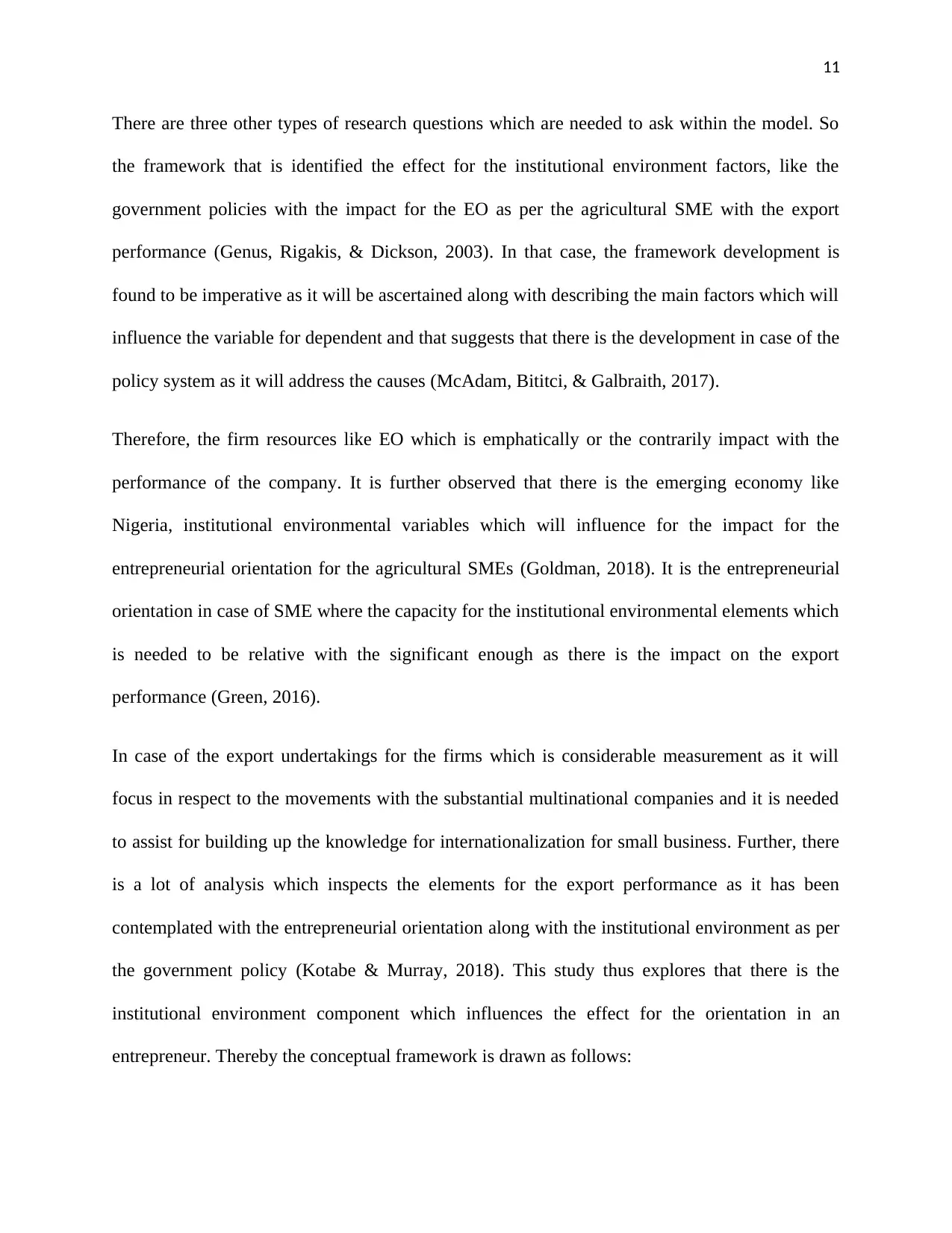
11
There are three other types of research questions which are needed to ask within the model. So
the framework that is identified the effect for the institutional environment factors, like the
government policies with the impact for the EO as per the agricultural SME with the export
performance (Genus, Rigakis, & Dickson, 2003). In that case, the framework development is
found to be imperative as it will be ascertained along with describing the main factors which will
influence the variable for dependent and that suggests that there is the development in case of the
policy system as it will address the causes (McAdam, Bititci, & Galbraith, 2017).
Therefore, the firm resources like EO which is emphatically or the contrarily impact with the
performance of the company. It is further observed that there is the emerging economy like
Nigeria, institutional environmental variables which will influence for the impact for the
entrepreneurial orientation for the agricultural SMEs (Goldman, 2018). It is the entrepreneurial
orientation in case of SME where the capacity for the institutional environmental elements which
is needed to be relative with the significant enough as there is the impact on the export
performance (Green, 2016).
In case of the export undertakings for the firms which is considerable measurement as it will
focus in respect to the movements with the substantial multinational companies and it is needed
to assist for building up the knowledge for internationalization for small business. Further, there
is a lot of analysis which inspects the elements for the export performance as it has been
contemplated with the entrepreneurial orientation along with the institutional environment as per
the government policy (Kotabe & Murray, 2018). This study thus explores that there is the
institutional environment component which influences the effect for the orientation in an
entrepreneur. Thereby the conceptual framework is drawn as follows:
There are three other types of research questions which are needed to ask within the model. So
the framework that is identified the effect for the institutional environment factors, like the
government policies with the impact for the EO as per the agricultural SME with the export
performance (Genus, Rigakis, & Dickson, 2003). In that case, the framework development is
found to be imperative as it will be ascertained along with describing the main factors which will
influence the variable for dependent and that suggests that there is the development in case of the
policy system as it will address the causes (McAdam, Bititci, & Galbraith, 2017).
Therefore, the firm resources like EO which is emphatically or the contrarily impact with the
performance of the company. It is further observed that there is the emerging economy like
Nigeria, institutional environmental variables which will influence for the impact for the
entrepreneurial orientation for the agricultural SMEs (Goldman, 2018). It is the entrepreneurial
orientation in case of SME where the capacity for the institutional environmental elements which
is needed to be relative with the significant enough as there is the impact on the export
performance (Green, 2016).
In case of the export undertakings for the firms which is considerable measurement as it will
focus in respect to the movements with the substantial multinational companies and it is needed
to assist for building up the knowledge for internationalization for small business. Further, there
is a lot of analysis which inspects the elements for the export performance as it has been
contemplated with the entrepreneurial orientation along with the institutional environment as per
the government policy (Kotabe & Murray, 2018). This study thus explores that there is the
institutional environment component which influences the effect for the orientation in an
entrepreneur. Thereby the conceptual framework is drawn as follows:
⊘ This is a preview!⊘
Do you want full access?
Subscribe today to unlock all pages.

Trusted by 1+ million students worldwide
1 out of 18
Related Documents
Your All-in-One AI-Powered Toolkit for Academic Success.
+13062052269
info@desklib.com
Available 24*7 on WhatsApp / Email
![[object Object]](/_next/static/media/star-bottom.7253800d.svg)
Unlock your academic potential
Copyright © 2020–2025 A2Z Services. All Rights Reserved. Developed and managed by ZUCOL.





